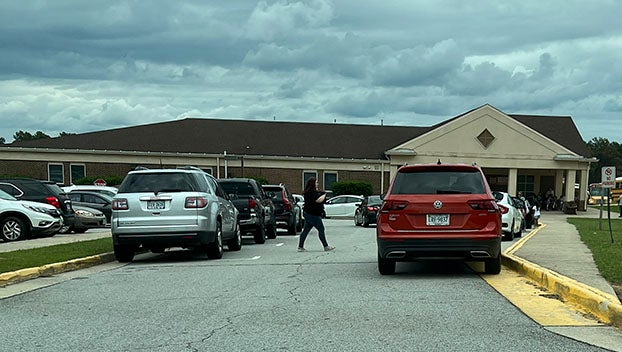Supervisors question decisions in Prince Edward County schools
Published 1:01 pm Tuesday, February 28, 2023
|
Getting your Trinity Audio player ready...
|
FARMVILLE – Why were Prince Edward County schools allowed to get in their current physical condition? Why is the county being constantly asked to pay for additional teachers, when the district can’t fill the open positions they have now? And where are the tangible results from extra funding provided to schools? Prince Edward County’s board of supervisors have questions for Superintendent Dr. Barbara Johnson and the Prince Edward County School Board. Those questions were all laid out during the first budget planning meeting of the year, on Wednesday, Feb. 22.
“There’s a lot of things they asked for and they never used the money for. They asked for additional teachers, quite a few of them (and) another counselor,” said District 8 Supervisor Pattie Cooper-Jones. “Nobody hired any of those people. And it’s not that they didn’t have the funding. So what really happens and why do you come to us with all these gigantic proposals about what you need and then you don’t even use the funds?”
Schools in Prince Edward County do still have vacant positions, both when it comes to teachers and staff. Based on the posted openings, updated as of Monday, Feb. 27, there are more than 12 current needs, with at least 11 more anticipated for the fall semester.
Current needs include a math teacher, science teacher, baseball coach and softball coach at Prince Edward High. At the elementary and middle school levels, the district needs a music teacher, a pre-k teacher, one special education teacher, one early education teacher, three paraprofessionals, a school psychologist and a middle school computer technology teacher.
If the school district isn’t spending the money on what it was given for, Cooper-Jones questioned if the county should just take that extra funding for new positions back.
“I’m sure the question is going to come, ‘can we just hold on to (the money), can we keep it?’ I think the board should really think about (saying) absolutely not,” Cooper-Jones said. “If it’s not used for what it was requested to be, cut it off. Send it back to the county, put it back in the county coffers and let it be used where it needs to be used.”
A vacancy problem
Teacher vacancies aren’t just a problem in Prince Edward County schools. It’s happening across this region and the overall state, where there’s currently an estimated 1,200 vacant positions. A survey of teachers by the National Education Association found part of the problem does come due to salary. Virginia teachers make an average of $58,506, the NEA says. That puts the Commonwealth 25th in the nation. The national average, by comparison, is $65,293. We reached out to the district and asked, but don’t have a current estimate for how much the average teacher salary is in Prince Edward County.
Another issue, both in this region and across the state, is burnout. The NEA study found Virginia teachers are quitting (and prospective applicants staying away) partly due to increasing expectations and requirements. They’re being asked to do more with the same amount of resources, same time involved and same pay. There’s also an issue of pay disparity when you try to bring someone in from another field.
“Finding a nurse or carpenter or a computer programmer who wishes to leave the private sector to teach for teacher pay is difficult to say the least,” the NEA report states. “Many teachers have been retiring from teaching after they reach that 30-year mark, even though they are not yet 65.”
Problems with Prince Edward County schools
The topic of schools came up during Wednesday’s budget discussion as District 1 Supervisor Harrison Jones mentioned that citizens want to see improvement.
“When people talk to me, they’re not really concerned about when the next remodel is coming for a convenience site. They want to see the schools (get) better.”
He asked what were the different tools supervisors had in order to help push for change. Prince Edward County Administrator Doug Stanley suggested they ask the school board and superintendent some questions.
Last year, the county sent a letter to the school district. In the letter, signed by the board of supervisors at the time, county officials pointed out they gave an extra $836,149 to the district for operational funds. But that money came with an expectation that “there will be measurable progress in student outcomes such as test scores, increasing graduation rates and declining absenteeism, as well as improved teacher retention,” the June 15, 2022 letter states.
“I think it’s fair to say hey we gave $800,000 in additional operational funding to help improve salaries and hire positions and do things in the school system,” Stanley said. “As part of that, we wanted to see improvement. What has improved in the schools? You gave the money with those strings attached. I think it’s a fair question.”
Questions of SOLs and absenteeism
When it comes to SOL (Standards of Learning) scores, the district saw more students pass the test in reading, math and science. The biggest improvement came in math scores, both at the high school and district level. Last year, only 21% of Prince Edward High students passed their math SOL. This year, that number hit 60%, more than double. Overall across the district, 51% of students passed the test, a big improvement over just 25% last year.
Another highlight in this year’s scores came in reading at Prince Edward High. A total of 75% of students passed their reading SOL, compared to 67% last year. The school’s pass rate was also higher than the state average, coming in at 73%.
On the question of absenteeism, however, it’s a problem across the district. In Prince Edward County, more than 35% of public school students were chronically absent during this year’s first semester.
This issue started before this year. During the 2021-22 school year, Prince Edward Elementary reported 27.5% of their students were chronically absent. In the same period, Prince Edward Middle reported 30.9% and the high school reported 47.7% of their students met that category.
To be clear, chronic absenteeism is defined as missing more than 10% of instructional days, including excused, unexcused and disciplinary absences. And Prince Edward is not alone, when it comes to dealing with chronic absences. Virginia Department of Education data shows last year, 29.8% or roughly one in every three Virginia students missed at least 18 days of school. That’s an increase over the 20.1% reported after the 2020-21 school year.
Prince Edward is close to the top, however. Dickenson County is one of the few higher, with 43.1% of students chronically absent. Bristol is another, at 34.9%.
The numbers alone raise concern, especially at Prince Edward High. But beyond just the simple numbers is a looming problem. Virginia’s Department of Education didn’t grade schools on absentee students for the last two years, due to the pandemic. The same is true this year. But that protection goes away after the current semester.
‘It’s not up to us to fix it’
Another issue that District 6 Supervisor David Emert sees is that the district in his view pushes the wrong construction projects at times. He pointed to the roof leaks at Prince Edward Elementary and the mold problems at the school as things that didn’t get addressed as small issues, so they’ve become bigger ones.
“Part of the water problems in those buildings should have been caught a long time ago, brought to their staff and said ‘this has to be fixed today’. Not tomorrow, not next week,” Emert said. “Let the grass grow. Let the football players do without. Let the track people do without. Fix the doggone roof before the building falls down. We’ve got a problem, but it’s not necessarily up to us to fix it, because we can’t. We have got to get the school board to realize their responsibility. Their whole job is to hold the school responsible. That’s what their job is.”
You can’t keep doing the same things and see the same results and say it’s alright, Emert added, saying those delays have expensive consequences.
“If the roof had been fixed seven years ago, there wouldn’t be mold in there,” he pointed out.
District 4 Supervisor Odessa Pride echoed Emert’s argument.
“It is not our responsibility as board members to get that school in order,” Pride said. “We do the funding, yes. But what are (they) doing as the superintendent, as the (school) board, what are (they) doing to make sure that (fixes) are getting done?”
What happens next with Prince Edward County schools?
Supervisors agreed to go and meet individually with school board members this week, to get answers to their questions. They also plan to make the funding questions clear when the joint finance committee, composed of county and school district employees, meets to talk about the budget. And finally, as budget talks continue, they plan to ask Superintendent Dr. Barbara Johnson herself when she comes before them for the district’s official presentation in March.






